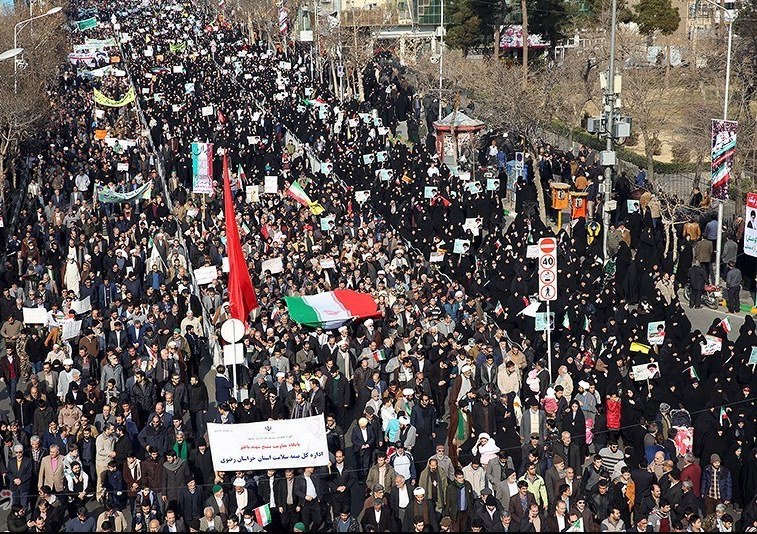In the final days of 2017, a series of anti-government rallies took place in Iran, taking by surprise both international observers and the Iranian society. Some argue the root cause was the nation’s poor economy and financial difficulties, while others believe the lack of political freedom in Iran was the primary reason and that “regime change” was the protesters’ ultimate demand.
 President Hassan Rouhani’s administration and other reformists initially found themselves in an unusual alliance alongside individuals from conservative camps, as they all spoke in support of the original demonstration that took place in the city of Mashhad. However, as the unrest continued and grew, many believed the nationwide protests occurred only with the support of “enemy” forces.
President Hassan Rouhani’s administration and other reformists initially found themselves in an unusual alliance alongside individuals from conservative camps, as they all spoke in support of the original demonstration that took place in the city of Mashhad. However, as the unrest continued and grew, many believed the nationwide protests occurred only with the support of “enemy” forces.
Domestic Rivalry
On December 29, one day after the initial rally in Mashhad, Iranian Vice President Eshaq Jahangiri blamed hardliners for staging a “show” that was intended only to criticize the Rouhani administration and weaken his leadership. The reason many people, including myself, believe Mr. Jahangiri’s argument made sense was because – unlike any other movements in the modern history of Iran – this movement began in Mashhad.
Mashhad is located in the northeast of Iran, bordering Turkmenistan, and is the home of most of the Afghan refugees and immigrants who live in Iran. The city is one of the seven most important and holy places in Shi’a Islam, and it is often crowded with religious pilgrims.
But Mashhad is also an important pillar of the conservative sector of the Iranian regime. Indeed, the city represents the power base of the conservative cleric, Ebrahim Raisi, who was President Rouhani’s main rival in the 2017 presidential campaign. (Rouhani won a decisive reelection to a second term, beating Raisi by 57% to 38.5%.)
On the day following the start of the Mashhad uprising, Mr. Raisi wrote on his Twitter account: “President Rouhani! Do you remember how you wanted to bring western culture and concerts to the holy city of Mashhad? Now listen, people in the streets are holding their concerts, with the music of ‘Death to Rouhani.’” [My translation.] I believe this tweet was an indication of support for the demonstrations, which many people believe were orchestrated by Raisi himself.
A Failing Economy
The uprising that began in Mashhad closely followed President Rouhani’s announcement of the national budget for this coming year. The budget was not what most people had anticipated and hoped for. Instead, it was a much more conservative budget compared to previous years, and one that indicated further hardship for the majority of people, particularly those who have already been suffering.
Iran’s economy has been in a state of hardship for a long time now; recent figures indicate an inflation rate of almost 10% and unemployment at around 12%, with no better economic prospects for at least the near future.
The role of the United States is essential, and Donald Trump’s hawkish adventures toward Iran – specifically those in favor of two key U.S. allies in the region, Israel and Saudi Arabia – have essentially crushed Iran’s hope for an economic turnaround. Trump’s opposition to the Iran nuclear deal and his stated support for continuing and strengthening sanctions have kept foreign investments away from Iran, due to their fear of U.S. retribution. These are important factors in the financial crisis Iran faces today.
Yet while these reasons are important, they are not the only causes of Iran’s ill economy. The nation has had a long history of corruption and financial mismanagement. Iran’s dependency on oil and other raw resources has forced the government to put all its eggs into the “basket” of crude oil. Moreover, the devastating eight years of war with Iraq, which were followed by years of efforts to address what the country lost during the war, have had lasting negative effects on the nation’s efforts to rebuild its economy.
By the end of the 1980-88 Iraq-Iran War, a major effort to liberalize the economy was initiated in Iran. Economic policy was formed around this new liberal ideology. A quarter-century later, however, we see negative results in the shrinking of the once-large middle class, plus a widening gap between the haves and the have-nots. Hence, Iran’s severe financial problems are unfortunately nothing new, so it is surprising that economic factors would be seen as a precipitating factor for the recent unrest.
Peaceful Discontent
Besides the economy, it is important to note that a majority of Iranians are unhappy with the social policies and the political gridlock in the country. There are numerous issues that have frustrated large sectors of the populace – such as the mandatory wearing of the hijab; the role of women in the political arena; the monopoly of power by certain groups; etc. Interestingly, most of these social and political desires and demands are not new either; rather, they date back to the birth of the Islamic Republic itself in 1979.
Since the war period, during which the nation was primarily concerned with survival and sovereignty, for the past three decades Iranians have been focused on change for the better. Iranians have proven time and time again that the only acceptable way they wish to make change is through a nonviolent and civilized path.
Throughout this era, the majority of Iranians have been fully committed to peaceful and nonviolent methods of activism. This claim is made evident as one looks at various movements within the country as well as the countless peaceful demonstrations on various issues that take place routinely in the country. Perhaps the greatest sign of this commitment is the high level of participation in both local and national elections.
A Turn Toward Violence?
A brief review of the recent unrest and its comparison with previous Iranian history indicates that although demonstrations, movements, and revolution are nothing new for the nation, this current model has had different characteristics.
The unrest that began in late December started from the holy city of Mashhad, as described above, instead of the cities of Tehran, Tabriz, Isfahan, or other large but more secular cities. Soon, demonstrations spread to smaller cities and towns that are unknown to many, while there were still no evident protests in these major cities. Rallies often started with slogans against President Rouhani and typically focused on the economy, but soon expanded to slogans criticizing Iranian foreign policy, such as “No Gaza, No Lebanon; My Life Is for Iran!”
That, I believe, was the moment in which the demonstrations developed a very different characteristic. Demonstrators began appearing with weapons and encouraging the use of violence. In the city of Izeh, a policeman was shot and killed by a hunting rifle; in Baluchistan, a soldier and another policeman were killed. In a social media post related to the latter incident, a man defended the killing, by writing: “We told them to join us, they declined, and while we are sorry we had to kill them, that only happened as the result of their own mistake.” [My translation.]
These demonstrators burned public buildings, such as banks, town halls, police stations, etc. I believe that destruction was their agenda. Their slogans changed drastically: they shouted, “The Revolution [of 1979] Was a Mistake!” and “We Want the [son of the last] King to Return!” and other slogans. Interestingly, economic and social demands were replaced by political change, and, in fact, the topic of “regime change.”
In one occasion, a demonstrator burned the Iranian flag. This was previously unheard of in Iran, and created a huge reaction on social media among Iranians of all walks of life. Iranian observers of the events questioned demonstrators’ respect for Iran and national sovereignty. Another demonstrator in the city of Dorood hijacked a fire truck and allowed it to propel without a driver down a steep road, which ended up crushing a car and taking the lives of a father and his 13-year-old son on January 1st.
I have noticed that a large percentage of those active on social media have encouraged others to adopt a path of violence. One man shared a video of himself showing his gun and proclaiming, “We all have these toys [pointing at the gun]; there are many of us in Iran [which indicated he was not inside Iran] with weapons, and we will kill you all.” Another Instagram user had a photo of knife and a religious outfit next to it, saying, “We will kill all the clerics.” I noticed a post on Twitter encouraging everyone to “carry weapons, make Molotov cocktails, and come into the streets.”
These social media posts have used photos from different historical times, while some are drawn from other country’s demonstrations, and I have even seen photos taken from movies and posted as if they were current events in the streets in Iran.
 It is painfully disappointing that this righteous demonstration, which enabled people who have suffered economic hardship for decades to nonviolently express outrage at their pain and suffering, has now been overshadowed by violence and accusations of “fake news.” The controversy regarding the origin of the unrest – as to whether religious conservatives primarily organized the Mashhad rally – and the violence that then spiraled out of control has primarily hurt the poor and powerless who have courageously spoken out. These Iranians have sadly watched how their legitimate demands were changed in form and character.
It is painfully disappointing that this righteous demonstration, which enabled people who have suffered economic hardship for decades to nonviolently express outrage at their pain and suffering, has now been overshadowed by violence and accusations of “fake news.” The controversy regarding the origin of the unrest – as to whether religious conservatives primarily organized the Mashhad rally – and the violence that then spiraled out of control has primarily hurt the poor and powerless who have courageously spoken out. These Iranians have sadly watched how their legitimate demands were changed in form and character.
When violence took the upper hand, the Iranian police, Iranian Revolutionary Guard, and Basijis (an Iranian paramilitary militia force that operates nationwide) quickly mobilized and took action. Tragically, 22 (mostly young) people lost their lives before the police crackdown brought back a general sense of order in the streets.
Many Iranian observers acknowledged the legitimacy of the key demands articulated in the original Mashhad rally, but there is no way to continue supporting this effort when violence is used to reach its goals. While our hearts bleed for the innocent lives that have been lost, unlike Iran’s Green Movement period (2009), this time it is very difficult to point one’s finger only at the authorities for the lives that have been lost.
When we look outside of Iran’s borders, a balanced perspective doesn’t leave much room for criticism of the regime’s efforts to crush the violent rallies. Looking globally we see the terrorist organization Mojahedin-E-Khalgh (known as MEK), which has long sought to violently overthrow the Iranian regime. But also we now hear vocal statements by the son of Iran’s late Shah (Reza Shah II), conservative Iranian American supporters of Trump, plus U.N. Ambassador Nikki Haley, hard-line military interventionist John Bolton (a former U.S. ambassador to the U.N.), and President Trump himself, as well as Israeli Prime Minister Netanyahu openly supported the opposition rallies in Iran. Saudi Crown Prince Mohammad bin Salman has been unusually quiet, although one should remember that in an interview last summer he revealed his plan for taking his country’s “proxy war inside the border of Iran.”
These days Iran’s story is only another reminder to us all that foreign threats and interventions have only one result: it destroys social justice by eliminating both its dreams and any concrete steps toward this goal.
Photos: (1) Demonstration against the Rouhani government’s economic policies in Kermanshah, Iran, on December 29, 2017, courtesy of WikiCommons; (2) Demonstration condemning the political unrest in Mashhad, Iran, on January 4, 2018, by Nima Najafzade, courtesy of Tasnim News Agency (Creative Commons license).







